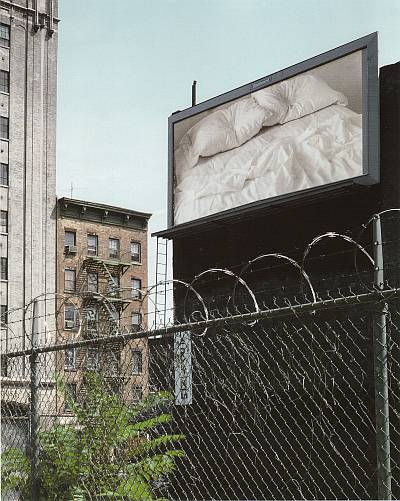the art of AIDS
Can Art Save Lives?
For most of the 1980s, the task of representing the AIDS epidemic was assumed by journalists, scientists, photographers and television producers. They constructed images of emaciated bodies waiting to die, and composed moralistic narratives of 'innocent' victims being infected by presumably 'guilty' gay men, bisexuals, prostitutes and drug users. Drawing upon the public's fear of a previously unknown and seemingly deadly disease, they portrayed people with HIV/AIDS (and the communities they came from) as 'dangerous', 'deviant', 'deserving' of their fate, and 'doomed'.
Such representations framed the way in which individuals understood the disease and had very real effects. Since cultural constructions of the epidemic are the only medium through which most people have 'contact' with, or can imagine, a person with AIDS, they help determine whether the public feel sufficient sympathy to support funding for AIDS research and medical care, and whether or not a person living with AIDS will be ostracised from the community, persecuted in public, discriminated against at work, or shunned as a lover or a friend. Moreover, the cultural constructions of the epidemic influence the way in which people with AIDS experience their own illness: whether they conceive of themselves as healthy and viable or sick and doomed, innocent victims of the epidemic or its guilty perpetrators who deserve to be feared and (self-) loathed.
The cultural representations of AIDS influence personal behaviour, psychological health and the direction of public policy, and thus significantly affects how, and if, people with HIV/AIDS live or die.
One of the primary aims of The Art of AIDS Prevention project is to demonstrate how, through the production of images and narratives that challenged existing myths and stereotypes, artists and cultural producers recast the stigmatising representations of people with HIV/AIDS, thus influencing personal behaviour, public attitudes and public policy.
In doing so, the project also examines the effectiveness of public health initiatives that utilised visual and performing artists and filmmakers, as well as cultural events, to educate about the risk of HIV transmission, and to heal and rebuild the communities that have been most severely affected by AIDS. Truly interdisciplinary in nature, this project is both a history of Australian, American and South African cultural production during an extraordinary time and an investigation into the efficacy of a bold and innovative approach to public health that depends on artists saving lives.

Felix Gonzalez-Torres, 'Untitled', 1991. Image on billboard, dimensions variable (installation at 31-33 Second Ave at East Second Street, Manhattan, for Project 34: Felix Gonzalez-Torres at MoMA, New York, 1992). Courtesy of the estate of Felix Gonzalez-Torres.